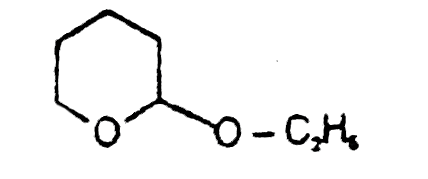The hydrolysis of acid anhydride produces..............
The correct Answer is:Two carboxylic acids
To solve the question regarding the hydrolysis of acid anhydride, we will follow these steps:
Step 1: Understand Acid Anhydrides
An acid anhydride is a compound formed by the removal of a water molecule from an acid. The general formula of an acid anhydride can be represented as R-C(=O)-O-C(=O)-R', where R and R' are hydrocarbon groups.
Hint: Remember that anhydrides are derived from acids by the loss of water.
Step 2: Hydrolysis Reaction
When an acid anhydride undergoes hydrolysis, it reacts with water. The reaction can be represented as follows:
R-C(=O)-O-C(=O)-R'+H2O→R-C(=O)-OH+R'-C(=O)-OH
This indicates that one molecule of water reacts with the acid anhydride.
Hint: Hydrolysis involves the addition of water to break the anhydride bond.
Step 3: Formation of Carboxylic Acids
The products of this hydrolysis reaction are two carboxylic acids. Each part of the anhydride contributes to the formation of a carboxylic acid. The resulting products can be represented as:
1. R-C(=O)-OH (Carboxylic acid from R)
2. R'-C(=O)-OH (Carboxylic acid from R')
Thus, the hydrolysis of one molecule of acid anhydride produces two molecules of carboxylic acids.
Hint: Identify the functional groups in the products to confirm they are carboxylic acids.
Conclusion
In summary, the hydrolysis of an acid anhydride produces two carboxylic acids.
Final Answer: The hydrolysis of acid anhydride produces two carboxylic acids.
---
An acid anhydride is a compound formed by the removal of a water molecule from an acid. The general formula of an acid anhydride can be represented as R-C(=O)-O-C(=O)-R', where R and R' are hydrocarbon groups.
When an acid anhydride undergoes hydrolysis, it reacts with water. The reaction can be represented as follows:
The products of this hydrolysis reaction are two carboxylic acids. Each part of the anhydride contributes to the formation of a carboxylic acid. The resulting products can be represented as:
2. R'-C(=O)-OH (Carboxylic acid from R')
In summary, the hydrolysis of an acid anhydride produces two carboxylic acids.
Topper's Solved these Questions
- REDUCTION, OXIDATION & HYDROLYSIS REACTIONSBOOK - RESONANCE ENGLISHCHAPTER - REDUCTION, OXIDATION & HYDROLYSIS REACTIONSEXERCISE - Part-II Only one option correct type
26 Videos
- REDUCTION, OXIDATION & HYDROLYSIS REACTIONSBOOK - RESONANCE ENGLISHCHAPTER - REDUCTION, OXIDATION & HYDROLYSIS REACTIONSEXERCISE - Part-III Match the column
2 Videos
- REDUCTION, OXIDATION & HYDROLYSIS REACTIONSBOOK - RESONANCE ENGLISHCHAPTER - REDUCTION, OXIDATION & HYDROLYSIS REACTIONSEXERCISE - Comprehension Type
3 Videos
- PERIODIC TABLE & PERIODICITYBOOK - RESONANCE ENGLISHCHAPTER - PERIODIC TABLE & PERIODICITYEXERCISE - ORGANIC CHEMISTRY(BASIC CONCEPTS)
27 Videos
- S BLOCK ELEMENTSBOOK - RESONANCE ENGLISHCHAPTER - S BLOCK ELEMENTSEXERCISE - ORGANIC CHEMISTRY(Biomolecules & Polymer)
4 Videos
Similar Questions
The hydrolysis of NCl3 by H2O produces
View SolutionCrO3 is an acid anhydride of
View SolutionHydrolysis of lipids produces
View SolutionAcid hydrolysis of sucrose is a
View SolutionThe product of acid hydrolysis of

is
View SolutionEthyl isocyanide, on hydrolysis with dilute sulfuric acid gives ............ and ........
View SolutionThe anhydride of nitric acid is:
View SolutionAcid hydrolysis of sucrose causes
View SolutionHydrolysis of nucleic acids yields purine, sugar, .................. And ..........................
View SolutionThe anhydride of carbonic acid is :
View Solution